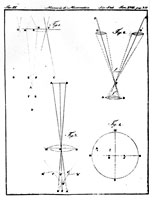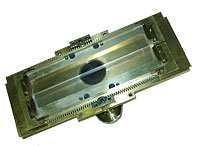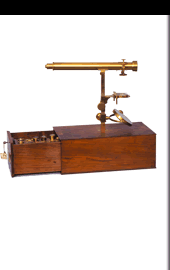Instruments
Micrometer
Amici had made a name for himself as a constructor of astronomical instruments as early as 1811. It was therefore logical that his micrometer received particular attention. He was concerned with it from the beginning of his activity and he dedicated his first publication to it, Descrizione di un nuovo micrometro (Description of a new micrometer), published in Vol. XVII-1816 of the “Memorie di Matematica e di Fisica della Società Italiana delle Scienze” (download pdf).
Amici believed that if one wanted to use the wire micrometer, no matter how precise, to measure the diameters of heavenly bodies or their respective distances, it was better to “limit oneself to determining only those which are perpendicular to their apparent motion, since the other distances or oblique diameters cannot be assigned with sufficient accuracy”. Herschel, Dollond and Ramsden had proposed different solutions to solve this limitation. But with the exception of Herschel’s solution, the other micrometers (double image, prismatic, objective) could not be attached to the large Newtonian telescopes, or at least not without many difficulties.
Amici therefore hoped to render astronomers a service with the construction of a new instrument which could be applied to the wide aperture telescopes and at the same time be easy to use and able to measure very small angles with a greater degree of precision than hitherto achieved.
 His instrument was based on the principle of the bisected lens, as was the construction of the objective micrometer as well. But the objective micrometer was judged by many to be defective. In particular Nevil Maskelyne (Account of a new Instrument for measuring small Angles, called the prismatic Micrometer, “Philosophical Transactions”, Vol. LXVII. For the Year 1777) believed he had found the real cause of one of the principal defects of the objective micrometer. When Amici had to choose a micrometer to use on his telescopes, he had to consider Maskelyne’s objections. A careful study of the theories of the Astronomer Royal convinced Amici that the reasons of the former were not supported by sufficient evidence and that the imperfections of the objective micrometer were fundamentally two:
His instrument was based on the principle of the bisected lens, as was the construction of the objective micrometer as well. But the objective micrometer was judged by many to be defective. In particular Nevil Maskelyne (Account of a new Instrument for measuring small Angles, called the prismatic Micrometer, “Philosophical Transactions”, Vol. LXVII. For the Year 1777) believed he had found the real cause of one of the principal defects of the objective micrometer. When Amici had to choose a micrometer to use on his telescopes, he had to consider Maskelyne’s objections. A careful study of the theories of the Astronomer Royal convinced Amici that the reasons of the former were not supported by sufficient evidence and that the imperfections of the objective micrometer were fundamentally two:
first of all, the impossibility, or at least extreme difficulty, of constructing lenses which can be attached to large catadioptric telescopes; and secondly, the aberration which the lenses themselves produce. This aberration, since it makes the outline of the images imprecise, disturbs the precision of the measurement of the angles. But by simply transporting Dollond’s micrometer between the objective and the eyepiece of a telescope, as I’ve imagined it, the first imperfection is removed and the second is so very diminished as to render it imperceptible. At the same time there is the advantage of a wider scale together with other benefits, and speed in observation.
He placed one of these micrometers on a Newtonian telescope with an eight-foot focus and eleven inches of aperture that he built.
The micrometer is attached to the outer part of the cursor that has the small flat mirror, where a graduated circle which indicates the position of the micrometer itself during its rotating movement is also fixed. The eyepiece is always equally distant from the half lenses, a distance of about seven inches, and precise vision in the telescope is obtained with the usual movement of the cursor to which the whole mechanism is applied.
The use of the micrometer that I have described is limited only to the smallest angles, which would itself be enough to make it useful, because a great deal of beautiful and interesting research is based on these measurements. All the same, I have tried to make it useful, and with the same degree of precision, for the measurement of wider angles, such as the diameter of the sun and of the moon. For this we need only two identical achromatic prisms whose refraction, when they are located in the telescope close to the lenses of the micrometers, is of about sixteen minutes and thirty seconds (G. B. Amici, Descrizione di un nuovo micrometro).
Amici returned to the subject nine years later with two letters to the Baron von Zach dated 17 January and 30 November 1823, entitled respectively Sur les micromètres prismatiques (download pdf ), and Nouveau micromètre intermédiaire
(cf. Micrometer Telescope). Von Zach published them in the “Correspondance astronomique” (vol. VIII-1823, p. 67-75; and vol. IX-1823, p. 517-534).
 In 1824 J.F.W. Herschel visited Amici in Modena twice during his tour through Italy, once in April and then again at the end of August or the first part of September. On 26 September Amici wrote Giovanni Plana: “It appears that Mr. Herschel was very satisfied with my instruments. He brings with him to London one of my distance measurers, and as soon as possible I will send him one of the large micrometers to apply to a seven-foot achromatic telescope which he wishes to use to measure double stars” (cf. A. Meschiari, Corrispondenza di G. B. Amici con Giovanni Plana, “Nuncius”, 1-2000).Once back in London, Herschel presented Amici’s micrometer to the first meeting of the Astronomical Society. His presentation was published in “Philosophical Magazine”, vol. 64 on 30 November 1824:
In 1824 J.F.W. Herschel visited Amici in Modena twice during his tour through Italy, once in April and then again at the end of August or the first part of September. On 26 September Amici wrote Giovanni Plana: “It appears that Mr. Herschel was very satisfied with my instruments. He brings with him to London one of my distance measurers, and as soon as possible I will send him one of the large micrometers to apply to a seven-foot achromatic telescope which he wishes to use to measure double stars” (cf. A. Meschiari, Corrispondenza di G. B. Amici con Giovanni Plana, “Nuncius”, 1-2000).Once back in London, Herschel presented Amici’s micrometer to the first meeting of the Astronomical Society. His presentation was published in “Philosophical Magazine”, vol. 64 on 30 November 1824:
Mr. Herschel submitted to the inspection of the members present, a new double image micrometer, by Professor Amici of Modena. The duplication of the image in this ingenious instrument is effected by interposing a divided concave lens of very long focus between the object and eye-glasses of a refracting, or between the mirror and eye-glass of a reflecting telescope. The separation of the centres of the two segments is performed by a rack and pinion sliding them on one another, their edges being preserved in contact, and is measured on a divided scale with a vernier in the usual manner. [...]
This micrometer possesses several advantages, among which may be reckoned, simplicity of construction and use; the magnitude of its scale, which may be increased to almost any extent by an increase of the focal length of the bisected lens [...]
Mr. Herschel in his visit to Modena, in the spring of the present year, had an opportunity of trying this instrument as applied to celestial objects, in one of M. Amici’s superb reflecting telescopes of 12 inches aperture and 8 feet focus.
In early 1825 Giovanni Santini, the astronomer from Padua, received the micrometer which he had ordered from Amici to use on the telescope of his Observatory. On 20 February Amici wrote him that “the micrometer which I had mounted on the telescope measures angles from zero up to four minutes and some seconds. Each minute has for value twenty divisions of the scale, and since the vernier is composed  of fifteen parts with it one has 2/10ths of a second. The minutes are numbered 1.2.3.4. with a zero beside them; this zero could have been left out by the engraver, to tell the truth, because they are only needed for a certain variation which the divisions of the scale undergo in their value when the micrometer is applied to a telescope with a different focus, or when the distance of the thread of the eyepiece to the plane of the divided lens changes. You will have realized that the doubled images of the objects are not equally brilliant in all of the areas of the field of vision, and that you can decrease the light of one or of the other as needed by moving the image away from the thread which divides as a diameter the field of the eyepiece. This is quite useful for measuring the distances of those double stars with very different sizes in which the brilliance of the larger of the two would obscure the smaller that has to be brought near to it.”
of fifteen parts with it one has 2/10ths of a second. The minutes are numbered 1.2.3.4. with a zero beside them; this zero could have been left out by the engraver, to tell the truth, because they are only needed for a certain variation which the divisions of the scale undergo in their value when the micrometer is applied to a telescope with a different focus, or when the distance of the thread of the eyepiece to the plane of the divided lens changes. You will have realized that the doubled images of the objects are not equally brilliant in all of the areas of the field of vision, and that you can decrease the light of one or of the other as needed by moving the image away from the thread which divides as a diameter the field of the eyepiece. This is quite useful for measuring the distances of those double stars with very different sizes in which the brilliance of the larger of the two would obscure the smaller that has to be brought near to it.”
Santini responded on 28 February: “I only have to study the theory”. Three years later (1828), Santini’s Teorica degli stromenti ottici (Theory of Optical Instruments), published in Padua, dedicated ample space to Amici’s double-image micrometer.
The Rev. William Pearson, vice president and treasurer of the Royal Astronomical Society, met Amici personally when the latter was in London in 1827, saw the micrometer Amici had and described it in his very-well documented work, complete with tables, entitled An introduction to practical astronomy, Longman, Rees, Orme, Brown, and Green, London 1829, vol. II, p. 564-567 (download pdf). The following is a small extract:
§ LXXXVI. Micrometer by Amici. [Plate XXI.]
1. At the time when we printed our descriptions of the various micrometers, we had not seen the double-image micrometer of the ingenious Amici of Modena, which we have mentioned at page 194; but the distinguished inventor has since been in England, and has supplied us with the identical instrument, which he had used in his observations of double stars. We have therefore now an opportunity of introducing an account of this micrometer. [...]
Amici’s micrometer was described again in 1867 by the astronomer Domenico Ragona (1820-1892), three years after his nomination to the Observatory of Modena: Sull’oculare a separazione di imaggini applicato all’Equatoreale del Reale Osservatorio di Modena (On the image-separating eyepiece attached to the equatorial telescope of the Royal Observatory of Modena), “Mémoires de la Société Impériale des Sciences naturelles de Cherbourg”, Tome XIII-1867, p. 289-312 + Pl. III:
The Royal Observatory of Modena has recently been enhanced thanks to a very elegant and valuable astronomical observation instrument, precisely, a magnificent image-separating eyepiece, invented and constructed by the famous scientist from Modena, G. B. Amici and first used by this writer when I adapted it to the new equatorial telescope.
Figure I (table III) shows the eyepiece end of this telescope, with the double-image micrometer. Inside the metal box s s' there are two rectangular lenses, posted on the same plane. The two lenses can be seen in l l', fig. 2, where the eyepiece is pictured from behind. The two lenses exactly fit into the inside edge, and they can slide one beside the other using two buttons b b' which the observer can find on the outsideof the box [...] The distance between the plane of the two lenses and the eyepiece is to the distance between said plane and the objective as 10 is to 73. [...] The eyepiece is positive [...] All the system of the metal box s s' and of the tube T with the eyepiece and the frame can be rotated.
